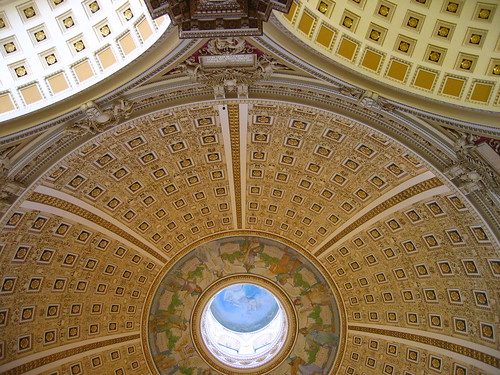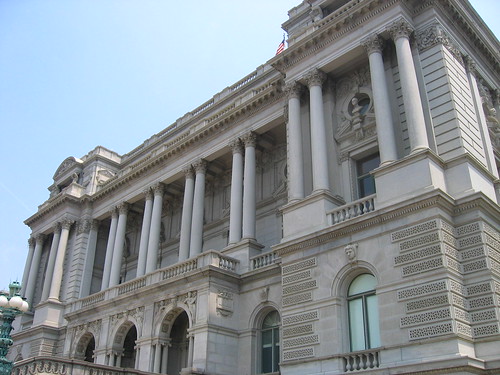This is the first of a new occasional series here on Metroblogging DC called “Essential DC” which will focus on experiences that are unique to DC, be they restaurants, places, events, or people. If you have a suggestion for an Essential DC experience, please suggest it to us! or if you’d like to guest-write an entry on an Essential DC experience, please send email to tom at metroblogging dot com and we’ll be glad to review it for publication!
I was sitting in class last night, wondering why it was that Amazon.com had so thoroughly shunned my attempts to purchase Stephen Hicks’ Explaining Postmodernism, when I realized that while I had checked all the county and city libraries within the beltway for the book, I had not checked the mother of them all, The Library of Congress. The Library of Congress has pretty much every book put out by an American Publisher in the last few centuries, so I figured it might be worth a venture. I began to seek entry into the Library itself, finding out that it is a closed Library, available to only those supplicants who present themselves to the Library in pursuit of Reason, Truth and Knowledge (or a reasonable facsimile thereof.)
Commissioned in 1800 and encompassed by the Capitol, its books were used for kindling by the invading British when they burned DC in the war of 1812. Rebuilt upon Thomas Jefferson’s personal collection at Monticello, the Library of Congress was reborn with 6,500 volumes after the war. The Library then began to grow prodigiously in size as the Copyright Law of 1870 required that two copies of any book submitted for copyright protection be submitted to the Library of Congress. The Jefferson Building was built in 1897, the Adams Building in 1939, and the most recent, the Madison Building was finished in 1980.
Its Main Reading Room on Pennsylvania Avenue is accessible only to those who apply for a Reader and Research card. Essentially, it is the Ultimate Library Card, and the key to knowledge arcane and obscure, poetic and philosophic, prose and biography.
The main reading room is the high temple to Knowledge universalis, and an architectural wonder. In its cupola dome are inscribed the gifts of Knowledge and who brought them to the forefront; from Greece and her Philosophy to America and her Science to Spain and her Discovery and Islam and her Physics, the contributions of the world are inscribed in the very firmament of the place. Below the dome stand the Disciplines: Science, Law, Poetry, Philosophy, Art, History, Commerce and Religion, accompanied by paired statues of the giants of those spheres. Newton and Henry representing Science, Solon and Kent representing Law, Moses and St. Paul representing Religion. Watched over by these sentinels, the readers sit in concentric circles of wooden desks, numbered so that your books may be delivered unto you by the acolytes of Knowledge.
This post appeared in its original form at DC Metblogs
The Library of Congress itself is a closed stack library, where only the staff of the Library may bring you a book, provided you have presented to them your LOC Reader ID. ID’s are issued to those who apply for them in the Madison Building on Pennsylvania Avenue. They’re designed not to be souvenirs, but I have a feeling that they end up that way more often than not after a single visit.
Cameras, Phones and Bags aren’t permitted in the reading room, though the LOC does provide a cloakroom for storing such things. Laptops are permitted, but only in their barest state, with not even a protective sleeve about them. There is no wireless access for a laptop, though there are ethernet jacks strewn about the undersides of the desks. Sadly, on my visit I had no ethernet cable to test them.
The Library of Congress Complex is located right across the street from the Capitol South Metro Station (Blue and Orange) and is open Monday through Saturday, with varying hours. Prospective Readers should enter the Madison Building from the Independence Avenue entrance and proceed through security to the Reader Registration department. ID cards are free.
This post appeared in its original form at DC Metblogs




